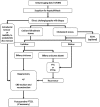Surgical management of hepatolithiasis
- PMID: 19590647
- PMCID: PMC2697895
- DOI: 10.1111/j.1477-2574.2009.00046.x
Surgical management of hepatolithiasis
Abstract
Background: Globalization and intercontinental migration have not just changed the socioeconomic status of regions, but have also altered disease dynamics across the globe. Hepatolithiasis, although still rare, is becoming increasingly evident in the West because of immigration from the Asia-Pacific region, where the disease prevails in endemic proportions. Such rare but emerging diseases pose a therapeutic challenge to doctors.
Methods: Here, we briefly introduce the topic of hepatolithiasis and describe features of intrahepatic stones, the aetiology of hepatolithiasis and the symptoms and sequelae of the condition. We then provide a comprehensive review of the various management modalities currently in use to treat hepatolithiasis.
Conclusions: In our opinion, and as is evident from the literature, surgery remains the definitive treatment for hepatolithiasis. However, non-surgical procedures such as cholangiography, although limited in their therapeutic capabilities, play a vital role in diagnosis and preoperative evaluation.
Keywords: hepatectomy; hepatolithiasis; percutaneous transhepatic cholangiography.
Figures






References
-
- Kayhan B, Akdogan M, Parlak E, Ozarslan E, Sahin B. Hepatolithiasis: a Turkey experience. Turk J Gastroenterol. 2007;18:28–32. - PubMed
-
- Park HS, Lee JM, Kim SH, Jeong JY, Kim YJ, Lee KH, et al. Differentiation of cholangiocarcinoma from periductal fibrosis in patients with hepatolithiasis. Am J Roentgenol. 2006;187:445–453. - PubMed
-
- Mori T, Sugiyama M, Atomi Y. Gallstone disease: management of intrahepatic stones. Best Pract Res Clin Gastroenterol. 2006;20:1117–1137. - PubMed
-
- Pockros PJ. Natural progression of untreated hepatolithiasis. J Clin Gastroenterol. 2001;33:95–96. - PubMed
LinkOut - more resources
Full Text Sources

